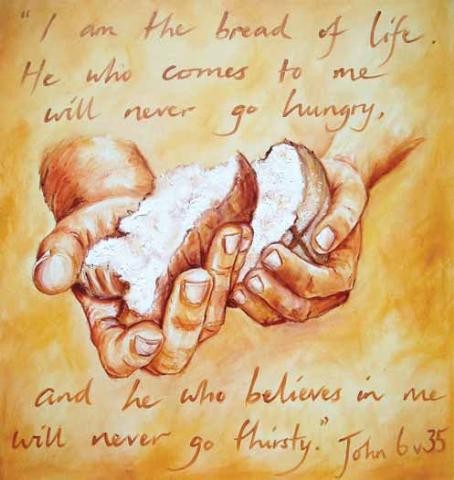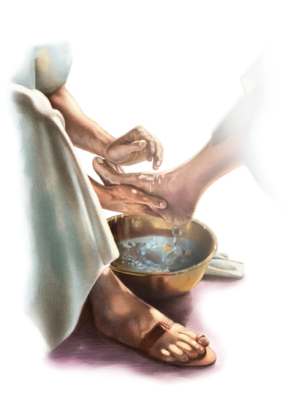HOLY THURSDAY – THE START OF THE SACRED TRIDUUM.
 The Thursday of Holy Week marks the beginning of the most sacred part of the Church’s year. Over the coming days, through the various liturgies, we shall be with Jesus in the upper room as he washes the disciples’ feet, gives us Himself under the appearance of bread and wine, is betrayed, tried, scourged and humiliated and finally crucified. But we shall also be with Him when he rises again on the third day. The Mass that evening celebrates the three gifts that Jesus gave to the Church: the priesthood, the Eucharist and a love that is greater than death.
The Thursday of Holy Week marks the beginning of the most sacred part of the Church’s year. Over the coming days, through the various liturgies, we shall be with Jesus in the upper room as he washes the disciples’ feet, gives us Himself under the appearance of bread and wine, is betrayed, tried, scourged and humiliated and finally crucified. But we shall also be with Him when he rises again on the third day. The Mass that evening celebrates the three gifts that Jesus gave to the Church: the priesthood, the Eucharist and a love that is greater than death.
The Mass that commemorates the Last Supper is slightly different. Before people arrive the Blessed Sacrament will have been removed from the tabernacle which now stands open and empty – there is no need to genuflect to it as you come into the church or at the start of the Mass. An ‘Altar of Repose’ will have been set up to where the Blessed Sacrament will be carried at the end of Mass and benches, water and towels for the washing of the feet will have been prepared. The colour of the vestments worn is white.
The Mass is also different because it has no end. There is no blessing or dismissal! This is because it is the first act in one single liturgical action that carries on with the Solemn Celebration of the Lord’s Passion on Good Friday and concludes with the Easter Vigil on Holy Saturday.
Mass begins as usual with the one difference that we do not genuflect to the Blessed Sacrament when we arrive at the sanctuary steps. Simply bow to the altar and go to your allotted place.
During the saying or singing of the Gloria the bells are rung. This will be the only time during this Mass. Afterwards they remain silent – even during the Consecration – until the Easter Vigil.
After the homily during which the preacher is called upon to develop the meaning of this sacred night, the mystery of the Eucharist, the priesthood, and the Love of Jesus, the One who kneels to serve, the washing of the feet takes place. When he celebrates Mass the priest stands in the place of Jesus Christ making present in our time what happened at the Last Supper. On this night emphasis is placed on the role of Jesus as One who serves by the priest following Jesus’ example – even the Holy Father will wash feet on this night; “’Do you understand’, he said, ‘what I have dine to you? You call me Master and Lord, and rightly; so I am. If I, then, the Lord and Master have washed your feet, you must wash each other’s feet. I have you an example so that you may copy what I have done to you.’” (John 13: 12-15 – from the Gospel read at the Mass). For this reason members of the congregation are invited to come up and wash each other’s feet – as a sign of humble service.
At the Last Supper, to wash the disciples’ feet, Jesus removed His outer garment and wrapped a towel around His waist. To copy this Father Paul will remove his chasuble and tie an amice around his waist.
 For the washing of the feet itself the people who are having their feet washed sit on the benches in front of the sanctuary steps and remove their footwear – traditionally from the right foot. Father Paul moves from person to person with a jug of water and a basin, washing the feet of each. Two altar servers are usually required: one with a supply of clean towels, the other to collect the used towels. Once this is over all the paraphernalia is cleared away and the Extraordinary Ministers of the Eucharist are invited to come forward and to be re-commissioned for another year.
For the washing of the feet itself the people who are having their feet washed sit on the benches in front of the sanctuary steps and remove their footwear – traditionally from the right foot. Father Paul moves from person to person with a jug of water and a basin, washing the feet of each. Two altar servers are usually required: one with a supply of clean towels, the other to collect the used towels. Once this is over all the paraphernalia is cleared away and the Extraordinary Ministers of the Eucharist are invited to come forward and to be re-commissioned for another year.
Mass then continues with the Bidding Prayers – the Creed is omitted. Following this and before the altar is prepared for the Liturgy of the Eucharist the three Sacred Oils that will be used in the Sacraments of the Church throughout the year are brought into the church. These will have been blessed and consecrated by the archbishop at the Chrism Mass earlier in Holy Week. That they are carried in by members of the community and the attention of people is drawn to them is a reminder of the importance of the sacraments in our lives of faith. The Sacred Oils are received by Father Paul at the sanctuary steps and are placed on a prepared table in a place of honour on the sanctuary.
Mass continues as normal with the difference, mentioned above, that the bells are not rung at the Consecration or immediately before Holy Communion.
After Holy Communion has finished preparations are made for the Transfer of the Blessed Sacrament to the Altar of Repose. Any remaining hosts – enough should have been Consecrated for Holy Communion on Good Friday – are placed in a ciborium. After the Blessed Sacrament has been incensed a humeral veil is placed around Father Paul’s shoulders. With this he enfolds the Blessed Sacrament and led by the altar servers and any concelebrating clergy he makes his way to the Altar of Repose. The pace of the procession, led by the cross bearer and acolytes, should be slow and reverent. The thurifer walks immediately in front of the Blessed Sacrament.
After the procession and when the Blessed Sacrament is secure everyone makes their way back to the sacristy in silence. When the usual reverence has been observed in the sacristy the altar is stripped without ceremony. Anything that is movable is removed: candles, cushions, altar cloths, furniture, even the water from the font and holy water stoup. The church enters its most bleak phase symbolising that the Lord has been taken away.
After Mass it is customary, if you can, to spend some time in silent prayer and meditation before the Altar of Repose recalling the disciples that accompanied Jesus to the garden of Gethsemane.